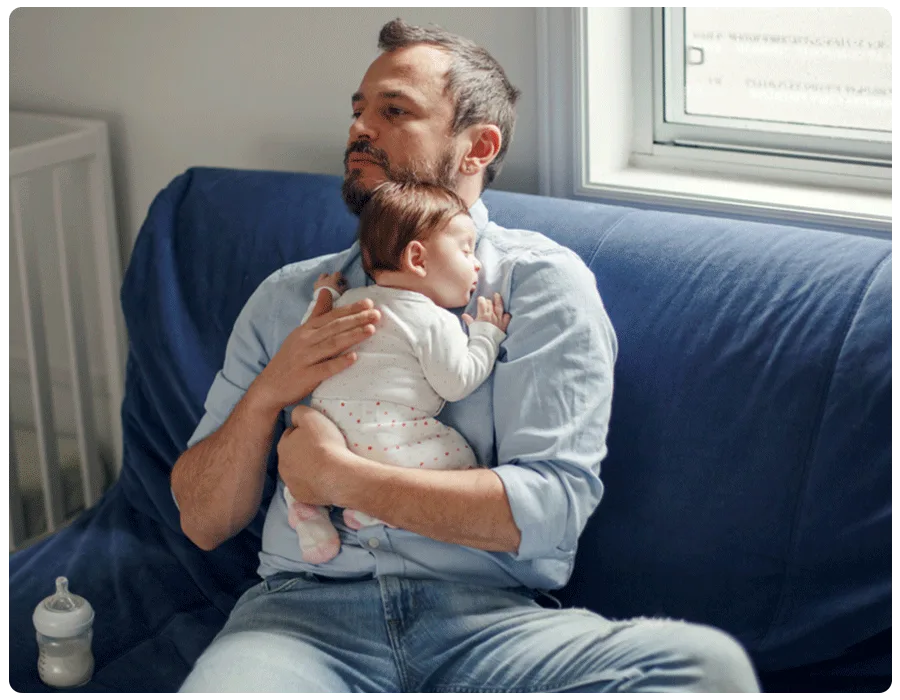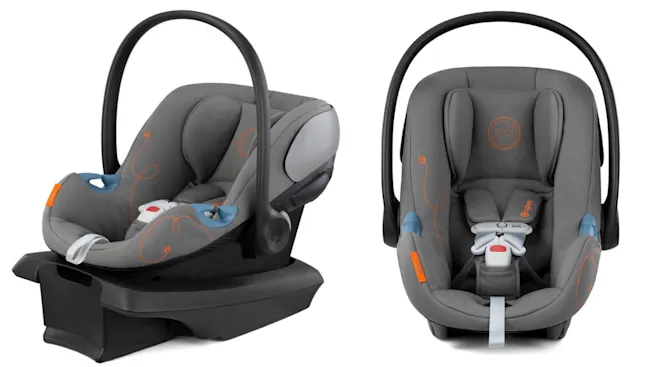How to Hold a Newborn Baby
Newborns are tiny—really tiny!—so if you’re daunted by the thought of holding them, you’re not alone. Even when they’re a bit older, baby may wriggle in your arms, so it’s important to know how to hold a baby properly. Moreover, it’s equally important to know how not to hold a baby. Ready to safely, securely and comfortably carry your cutie? Below, pediatricians break down tips to help make the snuggle less of a struggle.
There are a few different ways to hold a newborn baby, and specific positions will come in handy for certain situations (like breastfeeding and burping). Plus, there are some safety tips to keep in mind when holding a newborn (more on that below). Here, Alexis Phillips-Walker, DO, a pediatrician at Memorial Hermann Medical Group Pediatrics in Atascocita, Texas, walks us through a few different ways to hold a newborn:
Cradle hold
Hold baby’s head in one hand (with their back on your forearm) while resting it against your chest. Slide your other arm underneath to ensure baby’s bottom is supported. “This position is great for making eye contact with baby, which is helpful in development,” Phillips-Walker notes.
Upright position hold
Hold baby upright and rest them on your chest and shoulder, making sure to support their head and neck with one hand. Use your other hand to support baby’s bottom. This is also a great position for burping baby.
Belly hold
Place baby’s body belly-down across your forearm, with their neck supported by your forearm and their head supported by the crook of your elbow. Baby’s body will also be supported by the abdomen of the person holding them. This is another great position for burping baby and helping them to relieve gas.
Lap hold
In this position, your newborn’s back will be resting on both of your forearms, and their head and neck should be supported in both your hands. Not only is this a safe position for holding a newborn, but it also allows for good bonding time, says Phillips-Walker.
Football hold
As the name suggests, this position pretty much involves holding baby like a football and is primarily used for breastfeeding. Have baby’s back be on your forearm, with their head and neck supported by the palm of your hand, and angle them so baby’s stomach is towards yours. Phillips-Walker cites this as one of the safest ways to hold a newborn baby, particularly while seated.
Wondering how not to hold a newborn baby? Aside from leaving baby’s head and neck unsupported, there are a few other things to keep in mind to ensure you’re holding a newborn in the proper position:
- Don’t hold them with one hand: You never want to hold baby with one hand while standing, Phillips-Walker says—and you especially shouldn’t attempt to multitask by cooking or holding, say, a hot or cold drink in the other hand. Holding baby with both hands prevents accidents.
- Never pick baby up by their arms: When baby’s hands are up, and they’re asking to be held, it may seem intuitive to just lift them by their arms—but this could actually be dangerous. As Phillips-Walker explains, it puts too much stress on their joints and doesn’t provide proper head and neck support.
- Don’t shake baby: Shaking baby could cause shaken baby syndrome and other brain injuries. Loretta Cody, MD, a board-certified pediatrician based in Connecticut, says to avoid bouncing an unhappy newborn in an attempt to get them to stop fussing. “This movement can be jarring, and you don’t want to cause a shaking motion.” Instead, try to gently sway baby back and forth to soothe them. Also, don’t make any sudden or quick movements while holding a newborn or older baby.
- Don’t kiss them while you’re sick or recovering: If you are or have been recently sick, it’s best to keep your distance. Additionally, Cody cautions against kissing baby if you currently have or recently had a cold sore or any other blister around your mouth. These could be passed on and can cause serious illness for baby.
Newborns are delicate beings, so it’s important to keep the following safety tips in mind while holding them:
Always support baby’s head and neck
This is the most important part of holding a newborn (and likely something you’ve heard time and time again). Babies don’t typically develop head control until they’re around 4 months old. “It’s very important to prevent baby’s head from flopping side to side or from front to back,” advises Phillips-Walker. You’ll also want to ensure baby’s bottom is supported, adds Cody. Keep baby’s head, neck and bottom supported when passing them from one family member to the next, as well as when moving up and down stairs.
Be mindful of how you pass baby
Rather than extending baby forward, Cody says the person receiving baby should be close to and facing you: “Don’t let go until you’re sure the other person is fully supporting baby.”
Watch for baby’s fontanelles
Fontanelles are the two soft spots on a newborn’s head—in the back and on top—where the skull isn’t completely fused together. “[They] allow baby’s head to squeeze through the birth canal and allow room for brain growth,” Phillips-Walker explains. Though gently touching the fontanelles is okay, you want to avoid pressing down on them or hitting them with anything, since there aren’t yet bones protecting the areas.
Wash your hands
It’s a good idea to wash your hands before holding any baby, but particularly a newborn, Cody says. Newborns still have very fragile immune systems—and if they get sick it could be grounds for hospitalization.
Use proper posture
Baby won’t have any posture yet, but you’ll want to make sure you do when holding them for safety reasons. Cody recommends having a slight bend in your knees to avoid injuring your back.
Frequently Asked Questions
What if baby seems unhappy while being held?
If baby seems unhappy while being held, don’t assume you did something wrong. Baby could be fussy due to hunger, a skin irritation, gas pain, constipation or something else causing discomfort. If baby is still fussy despite your best efforts or seems inconsolable, reach out to your pediatrician.
How the best way to hold a days-old baby?
Per the AAP, the cradle hold is one of the most traditional ways to hold a newborn. Phillips-Walker also cites the football hold as a good way to hold a brand new baby. It’s both comfortable for them and provides a secure hold, particularly while you’re seated and breastfeeding.
Does holding a newborn affect their brain development?
According to research, holding a newborn may actually benefit their cognitive development. “Research has shown that nurturing touch actually helps infants gain weight and develop healthy relationships with caregivers,” Phillips-Walker says. “Holding and stroking infants stimulates the brain to release important hormones necessary for growth.” Plus, holding baby when they need or want to be held also helps strengthen your bond, as it helps create a secure attachment and improves your communication in terms of what baby needs when. “Several studies have shown that infants who are touched gently regularly have more brain responses than infants who are not,” she adds.
What is the best way to hold a newborn for skin-to-skin contact?
Per the American Academy of Pediatrics, the best way to hold a newborn for kangaroo care is to lay them on your bare chest under your clothing. Baby should also be nude, save for a diaper.
What are the best ways to hold a newborn for breastfeeding or bottle feeding?
As mentioned, there are several great ways to hold a newborn during breastfeeding, including the football hold, cradle hold, cross-cradle hold and side-lying hold. Learn more about the best breastfeeding positions here. For newborns, the cradle hold is typically the best and easiest way to bottle-feed.
What are the best ways to hold a newborn during burping?
The upright position hold is typically best when trying to burp a newborn, as well as the belly hold.
What are the best ways to hold a newborn during a bath?
According to Mayo Clinic, newborn baths require a secure hold, and the cradle hold is typically easiest here. You might also consider an infant bath tub with a newborn insert that can be used in the sink for those first few weeks and months.
When can you lift a child by their arms?
You should never lift a child by their arms at any age, according to Cleveland Clinic, as it can cause a condition called nursemaid’s or pulled elbow. This is when the elbow joint becomes partially dislocated, causing pain and lack of movement in the child’s arm.
When can you stop supporting baby’s head and neck while holding them?
You can start to reduce how much support you provide to baby’s head and neck as they develop proper head control, around 3 to 4 months. By 6 months old, most babies will be able to hold up their head with little to no extra support.
Please note: The Bump and the materials and information it contains are not intended to, and do not constitute, medical or other health advice or diagnosis and should not be used as such. You should always consult with a qualified physician or health professional about your specific circumstances.
Plus, more from The Bump:
Loretta Cody, MD, is a board-certified pediatrician based out of Connecticut. She received her medical degree from New York Medical College and completed her residency at Yale New Haven Children’s Hospital.
Alexis Phillips-Walker, DO, is a pediatrician with Memorial Hermann Medical Group Pediatrics Atascocita in Atascocita, Texas. She earned her medical degree at Ohio University College of Osteopathic Medicine in Athens.
American Academy of Pediatrics, Positions for Breastfeeding, November 2020
Michigan State University, Nurturing touch: An essential prescription for good social emotional health, June 2013
American Academy of Pediatrics, Skin-to-Skin Contact: How Kangaroo Care Benefits Your Baby, February 2024
Mayo Clinic, Baby bath basics: A parent's guide, February 2022
Cleveland Clinic, Why You Shouldn’t Pick Up or Swing a Child By the Arms, July 2021
Learn how we ensure the accuracy of our content through our editorial and medical review process.
Navigate forward to interact with the calendar and select a date. Press the question mark key to get the keyboard shortcuts for changing dates.


























































